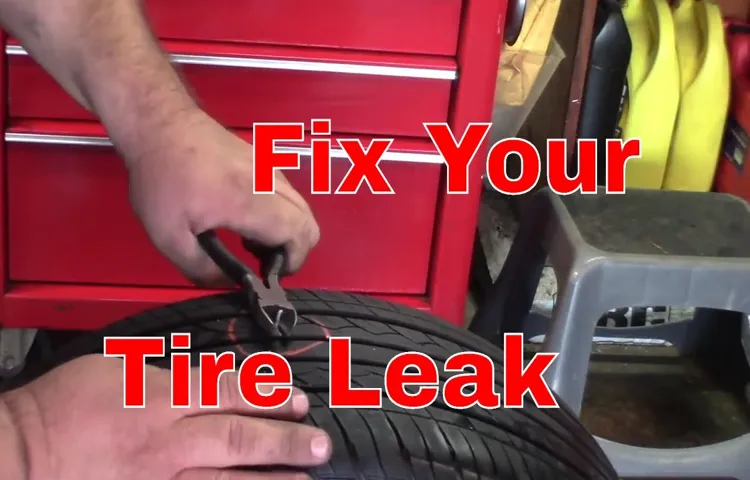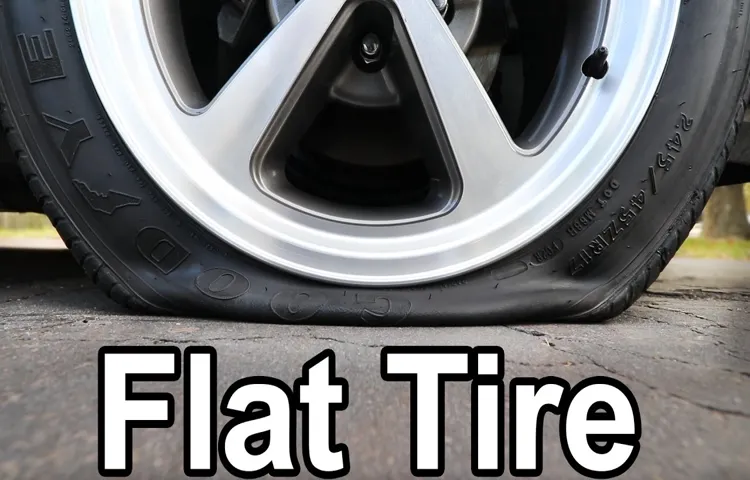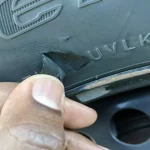Have you ever found yourself in the middle of nowhere with a flat tire and no idea what to do? It can be a frustrating and stressful situation, but don’t panic! Knowing how to fix a flat tire is an essential skill that every driver should have. In this blog post, we’ll walk you through everything you need to know about fixing a flat tire, from assessing the damage to getting back on the road safely. So, grab your spare tire and let’s get started!
Table of Contents
Gather the Necessary Tools
If you find yourself in a situation where you need to fix a flat tire, the first step is to gather the necessary tools. You will need a spare tire, tire jack, lug wrench, and wheel wedges. The spare tire is usually located in the trunk of your vehicle, but make sure you check the owner’s manual to confirm its location.
The tire jack and lug wrench also come with the vehicle and are usually found in the trunk or under the hood. Wheel wedges, on the other hand, prevent your vehicle from rolling and can be found at most auto parts stores. Before beginning the repair process, make sure you have all of these tools readily available to ensure a safe and efficient tire repair.
Always keep in mind that safety should be your top priority!
Tire repair kit
When it comes to dealing with a flat or damaged tire on the road, having a tire repair kit can be a lifesaver. But before you hit the road with your kit, it’s important to gather all the necessary tools. Some tire repair kits come with everything you need, but others require you to bring your own tools.
Some essential tools to have include pliers, a tire gauge, a tire valve tool, and a tire repair tool such as a plugger or patching kit. It’s also a good idea to make sure you have a small portable air compressor or tire inflator to re-inflate the tire after it’s been repaired. By making sure you have all the tools you need, you can handle any tire emergencies that come your way with ease.
Remember, prevention is better than cure. Therefore, it is better to be prepared than being caught off guard.

Tire lever
If you’re planning on changing a tire, you’ll need a set of tire levers. These tools are essential for removing tires from wheels, making the process go much smoother and easier. To start with, you’ll need to gather all the necessary tools.
Besides the tire lever itself, you’ll want to have a jack, wrench, and spare tire handy. It’s important to make sure that the spare tire is in good condition and properly inflated before attempting to use it. You may also want to invest in some protective gloves to prevent injury during the process.
Once you have all your tools together, you’ll be ready to start changing your tire. Make sure to follow all safety guidelines and take your time to avoid making any mistakes. With a bit of practice, you’ll be able to change a tire quickly and easily using your trusty tire levers.
Spare tube or patch kit
When it comes to cycling, it’s important to always be prepared for any situation you may encounter on your ride. One of the most common mishaps that can occur while cycling is a flat tire. That’s why it’s essential to carry either a spare tube or a patch kit with you at all times.
A spare tube is a great option if you’re not comfortable repairing a flat while out on a ride or if you experience multiple flat tires. On the other hand, a patch kit is a suitable choice if you want to save space and money. Whichever option you choose, make sure you also have tire levers and a pump to assist you in the replacement or repair process.
As a cyclist, always aim to be equipped with these essential tools to avoid being stranded on the side of the road.
Air pump or CO2 cartridge
When it comes to inflating tires, choosing between an air pump and CO2 cartridge can be a daunting task. But don’t worry, with the right tools, you can easily inflate your tires without any hassles. First, gather the necessary tools such as a tire pressure gauge, air pump or CO2 cartridge, and a valve adapter.
If you prefer using an air pump, make sure that it’s compatible with your bike valve. On the other hand, CO2 cartridges are known for their convenience and portability. However, they can be expensive and you might need multiple cartridges to inflate a single tire.
Overall, both options have their pros and cons, so it’s ultimately up to personal preference. Just make sure that you’re prepared with the right tools before you begin inflating your tires, so that you have a smooth and hassle-free experience.
Locate the Flat Tire
If you’ve found yourself with a flat tire and need to know how to fix it, the first step is to locate where the tire is damaged. Sometimes, this can be easy to spot due to a visible puncture or tear, but other times it’s not as obvious. One way to locate the flat is to visually inspect the tire for any foreign objects, such as nails or rocks, that could have caused the damage.
Another way is to feel around the tire’s surface for any abnormal bulges or bumps, indicating where the air is escaping. If you’re still unsure, you can also spray the tire with soapy water and look for bubbles, as they will indicate where the leak is coming from. Regardless of the method you choose, once you’ve located the flat, you can proceed with fixing it.
Remember to use caution and wear protective gear when working on your vehicle. With a little patience and some know-how, you’ll be back on the road in no time.
Move bike to a safe location
When you notice that you have a flat tire while biking, it’s important to move your bike to a safe location. This could mean getting off the road or finding a nearby sidewalk or park where you can work on your bike without worrying about traffic. Once you’ve found a safe spot, the next step is to locate the flat tire.
This can be done by gently spinning the wheel and listening for the tell-tale hissing sound of air escaping from the puncture. You can also run your hand along the tire to feel for any bumps or irregularities that may indicate a flat. Once you’ve identified the problem, it’s time to set to work on fixing the flat so you can get back to enjoying your ride.
Remember to take your time and work carefully to ensure that you don’t cause any further damage to your bike or tire. With a bit of patience and know-how, you’ll be back on the road in no time.
Identify which tire is flat
If you ever find yourself with a flat tire, the first step is to locate which tire needs attention. Firstly, take note of any unusual noises or vibrations while driving, as this could indicate a flat tire. Then, step out of the vehicle and visually inspect each tire.
Look for any obvious signs of damage, such as a puncture or tear in the rubber. If you can’t immediately identify which tire is the culprit, try gently pressing down on each tire with your hand. If one tire appears to be noticeably flatter than the others, that’s likely the one that needs to be checked.
Another option is to use a tire pressure gauge to check the air pressure in each tire. If one tire is significantly lower than the others, it’s probably the one that needs attention. Remember to always exercise caution when checking for a flat tire, and never attempt to drive on a flat tire as it can lead to serious damage.
Remove the Tire
To fix a flat tire, the first step is to remove the tire from the vehicle. You’ll need to use a jack to lift the car off the ground, and then remove the lug nuts with a lug wrench. After the lug nuts are removed, you can then carefully pull the tire off the wheel hub by pulling it towards you.
It’s important to be careful during this step to avoid damaging the wheel hub or the tire itself. Once the tire is removed, you can examine it to locate the source of the puncture or damage. This may include anything from a small nail or screw to a larger gash or tear in the tire.
With the tire removed from the vehicle, you can then move on to the next steps of repairing or replacing the tire to safely get back on the road. Remember to always exercise caution when working with a tire, and be sure to properly secure the vehicle before starting the repair process.
Release air from tire
If you are trying to remove a tire, the first step is to release the air from the tire. This may seem like a simple process, but it’s important to do it correctly so you don’t damage the tire or the rim. Start by finding the valve stem on the tire, which is usually located near the rim.
Then, use a valve stem cap removal tool or a pair of pliers to remove the cap covering the valve stem. Depress the small pin in the middle of the valve stem with a valve stem removal tool or a pen. This will release the air from the tire slowly and safely.
Make sure to release all of the air from the tire before attempting to remove it from the rim. This will make the process easier and prevent any accidents or injuries. With a little patience and care, you can safely release the air from your tire and move onto the next step of removing it from the rim.
Remember to always take safety precautions and wear protective gear when handling tires.
Use tire lever to remove tire from wheel rim
Removing a tire from a wheel rim can be a tricky task, but with the right tools and technique, it can be done with ease. One essential tool for this job is a tire lever, which makes the process much easier by helping to pry the tire away from the rim. To begin, place the wheel on a flat surface, and use the lever to wedge the tire away from the rim, starting at one point and moving around the circumference of the wheel.
It’s crucial to work slowly and carefully, taking care not to puncture the inner tube in the process. Gently pull the tire up and away from the rim until it is fully removed. With a little practice, removing a tire can be a quick and straightforward process.
However, if you’re unsure or uncomfortable with the process, it’s always best to seek the help of a professional.
Patch the Tube
Fixing a flat tire is a necessary skill for any cyclist, especially if you frequently ride on rough terrains or in urban areas. While some cyclists carry spare tubes with them, it’s essential to know how to patch the tube in case of unexpected punctures. The process may seem tricky at first, but it’s actually fairly simple once you get the hang of it.
Start by removing the wheel and tire from the bike, then deflate the tire completely. Next, locate the puncture and sand the surrounding area with sandpaper. Apply the adhesive patch, making sure it’s centered on the puncture, and smooth out any air bubbles with your fingers.
Finally, replace the tire and rim on the wheel before inflating it and putting it back on your bike. With a little practice and patience, you can quickly and easily patch a flat tire, making sure you’re back on the road in no time!
Locate hole in tube
When it comes to fixing a flat tire on your bike, the first step is to locate the hole in the tube. One way to quickly identify the puncture is to inflate the tube and immerse it in water. Look for bubbles emerging from the tube, which will indicate the spot where the air is escaping.
Once you have located the hole, you can proceed with patching it up. Make sure to clean the area around the puncture with a dry cloth before applying the patch. Peel off the backing of the patch and press it firmly onto the puncture, ensuring there are no air bubbles trapped beneath it.
Rub the patch down with a smooth, hard object to ensure a tight seal. Finally, re-inflate the tire to the recommended pressure and check the patch for any leaks. With these simple steps, you can quickly patch a tube and get back to your ride in no time.
So don’t let a flat tire keep you off your bike, locate the hole and patch it up with ease.
Apply patch to hole
So, you’ve got a hole in your bike tire tube and you’re not quite sure what to do about it. Don’t worry, patching the tube is a fairly simple process that can save you from having to replace the entire tube. First, remove the tire from the wheel and locate the puncture.
Once you’ve found the hole, use a piece of sandpaper or a metal file to rough up the area around it, making sure to remove any debris or remaining bits of inner tube material. Next, apply a small amount of rubber cement to the area and let it dry for a few minutes until it’s tacky to the touch. Then, take a patch and apply it over the puncture, making sure to press it firmly into place with your fingers.
Finally, reassemble the tire and wheel and inflate the tire to the recommended pressure. And there you have it – a patched tube that’s ready to hit the road again. Remember, prevention is key, so make sure to regularly inspect your tire for punctures and keep them properly inflated to avoid future issues.
Reinflate the Tire
If you’ve ever had a flat tire, you know how frustrating it can be. But with a little know-how, you can fix it yourself and avoid the expense and hassle of a tow truck or mechanic. One of the first steps in fixing a flat tire is to use a can of fix-a-flat to reinflate the tire.
Simply attach the nozzle to the valve stem and press the button to release the foam sealant. This will temporarily plug the puncture and reinflate the tire enough to get you to a repair shop or gas station. Just be sure to drive slowly and carefully to avoid damaging the tire further.
Once you’re back on the road, it’s always a good idea to have the tire repaired or replaced as soon as possible to prevent any further issues down the line. Overall, knowing how to put fix a flat in a tire is an essential skill for any driver, so don’t hesitate to learn and practice it. It could save you time, money, and stress in the long run!
Use air pump or CO2 cartridge to inflate tire
If you ever find yourself with a flat tire, the first thing you want to do is re-inflate it. You have two options when inflating your tire – using an air pump or a CO2 cartridge. If you’re at home or a bike shop, using an air pump is the best choice as it’s cheaper and eco-friendlier.
In contrast, for on-the-go repairs or in a race, CO2 cartridges are preferable as they inflate your tire quickly and easily. To use an air pump, you need to connect the pump to the valve stem on your tire. Make sure the pump fits well onto the valve so air doesn’t leak out.
Next, pump the handle up and down until your tire has reached its desired pressure. With a CO2 cartridge, first, attach the cartridge to the inflator head, and then screw the head onto the valve stem. Finally, release the CO2 into the tire by pulling the inflator trigger.
Both methods are simple to use, so make sure to carry a pump or cartridge in your bike bag for emergencie.
Reinstall the Tire
Now that you’ve repaired your flat tire, it’s time to put it back on your vehicle. Begin by matching up the lug bolts with the holes on the wheel. Hand tighten each lug bolt until they’re snug.
Then, use a torque wrench to tighten the bolts in a star pattern. Ensure that each bolt is tightened to the manufacturer’s recommended torque specifications. This will prevent overtightening and uneven distribution of pressure on the wheel.
Once you’ve tightened the bolts, it’s time to lower the vehicle back down to the ground. Don’t forget to remove the jack stands and put them away before driving the vehicle again. With these steps, you’ll be back on the road with a fully repaired and properly installed tire in no time.
Ensure tire is properly seated on wheel rim
When it comes to changing or reinstalling a tire, one of the essential steps to ensure your safety on the road is to ensure the tire is correctly seated on the wheel rim. Sometimes, the tire can slip off its proper position, causing a potential hazard. To fix this issue, you need to remove the tire from the rim, check for damages, and reinstall it correctly.
To reinstall the tire, start by lubricating the rim with a suitable lubricant. This will help slide the tire onto the rim without any friction. Next, align the tire with the valve hole on the rim and push it over the rim’s edge.
Make sure the tire’s bead is centered within the rim’s walls and not caught or twisted over them. Then, use your tire levers or your hands to tug the tire’s bead over the rim’s edge until it snaps into place. Ensure that you have done this on both sides of the tire.
Finally, inflate the tire to the recommended pressure and inspect the entire wheel for any signs of abnormalities. By taking these steps, you can ensure that your tire is correctly seated and will function correctly on the road. If you’re unsure of any of these steps, it’s best to seek professional help before attempting to reinstall the tire yourself.
Remember, your tire’s correct installation is vital to your safety, and you shouldn’t overlook this matter. By following these steps, you can stay safe on the road and avoid any potential hazards that come with improperly seated tires.
Pump tire to desired pressure
After making sure the tire is properly seated in the rim and you have placed the valve stem back into the hole, it’s now time to inflate the tire to the desired pressure. Grab your trusty pump and get ready to add some air. Make sure to reference the recommended pressure range stated in the owner’s manual or the tire’s sidewall.
Inflating a tire to the proper pressure is crucial to ensure optimal performance and safety while riding. Overinflated tires can cause a harsher ride and increase the risk of a blowout, while underinflated tires can cause decreased handling, increased tire wear, and reduced fuel efficiency. With that said, pump up the tire until you reach the desired pressure range, making sure it’s not under or overinflated.
Once done, give the tire a quick spin and check for any leaks or hissing sounds, indicating a possible puncture or valve leak. If everything looks good, you’re ready to hit the road with confidence and peace of mind.
Conclusion
Well, there you have it folks! Fixing a flat tire may seem daunting at first, but with a little bit of know-how and the right tools, it can be a breeze. Just remember to locate the puncture, remove the debris, insert the repair tool, and inflate the tire to the proper pressure. And if all else fails, just blame it on a rogue nail or pesky pothole.
Happy fixing!”
FAQs
What is Fix a Flat and how does it work?
Fix a Flat is an aerosol canister that contains a liquid foam sealant, which can be used to temporarily seal punctures in tubeless tires. When sprayed into the tire, it uses the pressure of the air inside the tire to force the sealant into the hole, sealing the puncture.
Can Fix a Flat be used on all types of tires?
Fix a Flat is meant for use on tubeless tires only, including car, truck, SUV, ATV, and motorcycle tires. Do not use Fix a Flat on motorcycle tires with inner tubes, or on bicycle tires.
How long will Fix a Flat seal a tire?
Fix a Flat is designed as a temporary fix, and is not a permanent solution. The sealant should allow you to drive the vehicle for a short period of time, typically 50-100 miles, giving you time to get the tire replaced or repaired.
Is Fix a Flat easy to use?
Yes, Fix a Flat is very easy to use. Simply remove the cap, attach the hose to your tire valve, and press the nozzle to fill the tire with the sealant. It can be done without any special tools or knowledge.
Can Fix a Flat damage my tire or wheel?
Fix a Flat is generally safe for use on your tires and wheels, although it can cause some cosmetic damage or discoloration. However, it is important to get the tire repaired or replaced as soon as possible after using Fix a Flat to prevent any further damage or potential safety hazards.
Can Fix a Flat be used more than once on the same tire?
It is not recommended to use Fix a Flat more than once on the same tire. The sealant can build up over time and cause balancing or handling issues with the tire.
Can I still use Fix a Flat if I don’t have a spare tire?
Yes, Fix a Flat can be a useful option if you don’t have a spare tire. It can give you enough time to drive to a tire repair shop or to get a new tire. However, it is still important to have the tire inspected and repaired or replaced as soon as possible.



